Laptop and Smartphone in hand-carry only
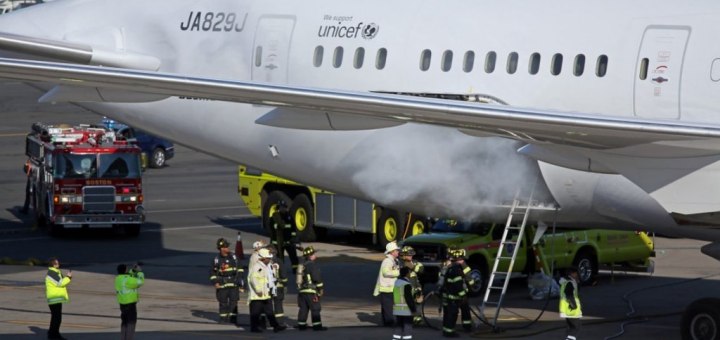
ICAO Council Prohibits Lithium-Ion Cargo Shipments on Passenger Aircraft
MONTRÉAL, 22 FEBRUARY 2016 – The 36-State ICAO Governing Council adopted a new aviation safety measure today which prohibits, on an interim basis, all shipments of Lithium-ion batteries as cargo on passenger aircraft.
“Safety is always our most fundamental priority in international civil aviation,” stressed Dr. Olumuyiwa Benard Aliu, ICAO Council President. “This interim prohibition will continue to be in force as separate work continues through ICAO on a new lithium battery packaging performance standard, currently expected by 2018.”
The Council’s decision will be effective 1 April, 2016. It pertains only to Lithium-ion batteries shipped as cargo on passenger aircraft, and not to those contained in personal electronic devices carried by passengers or crew. It comes subsequent to extensive reviews undertaken by the ICAO Air Navigation Commission, and the UN agency’s Dangerous Goods, Flight Operations, and Airworthiness panels.
The prohibiting of Lithium-ion cargo shipments on passenger aircraft has been eagerly awaited by aircraft manufacturer and pilots associations, which have been the most vocal advocates for the new safety measure.
Some nasty samples
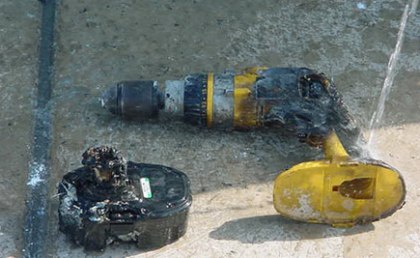 A power tool
A power tool 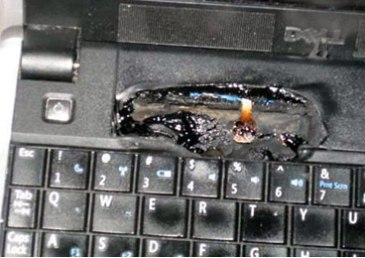 A laptop
A laptop 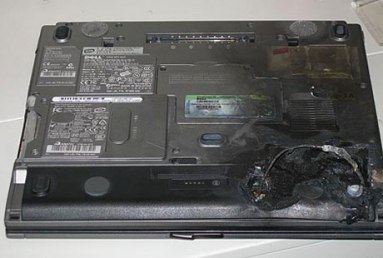 Another laptop
Another laptop 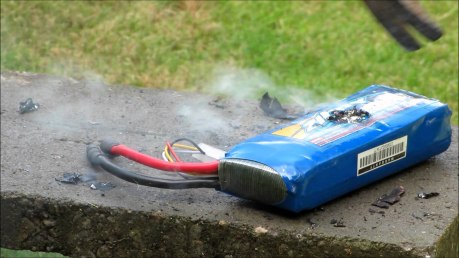 A power pack
A power packLaptop and Smartphone
It’s a pity that industry has not yet been able to build safe Lithium-ion batteries. We can understand that the airlines and pilots do not want these potentially dangerous items in the cargo bays of their aircraft.
- What happens when my laptop computer or my power-bank starts to burn up in the hand-carry bin?
A small Li-ion fire can be handled like any other combustible fire. For best result use a foam extinguisher, CO2, ABC dry chemical, powdered graphite, copper powder or soda (sodium carbonate). If the fire occurs in an airplane cabin, the FAA instructs flight attendants to use water or soda pop. Water-based products are most readily available and are appropriate since Li-ion contains very little lithium metal that reacts with water. Water also cools the adjacent area and prevents the fire from spreading. Research laboratories and factories also use water to extinguish Li-ion battery fires. Halon is also used as fire suppressant, but this agent may not be sufficient to extinguish a large Li-ion fire in the cargo bay of an aircraft. - How dangerous are Lithium-ion batteries?
Lithium-ion is safe but with millions of consumers using batteries, failures are bound to happen. In 2006, a one-in-200,000 breakdown triggered a recall of almost six million lithium-ion packs. Sony, the maker of the lithium-ion cells in question, points out that on rare occasion microscopic metal particles may come into contact with other parts of the battery cell, leading to a short circuit within the cell.
Battery manufacturers strive to minimize the presence of such particles; however, complex assembly techniques make the elimination of all metallic dust a challenge. Cells with ultra-thin separators of 24µm or less (24-thousandth of an mm) are more susceptible to impurities than the older designs with lower Ah ratings. Whereas the 1,350mAh cell in the 18650 package could tolerate a nail penetration test, the high-density 3,400mAh can ignite when performing the same test. - Are Lithium-ion batteries only used in my Laptop and Smartphone?
No, Li-ion batteries are used in almost any electronic gadget, electric and electronic toys and of course in all wireless power-tools. If you need to put such items in your checked luggage, make sure to remove the batteries and put them in your hand-carry luggage.
[GARD]



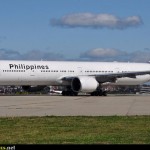



Recent Comments